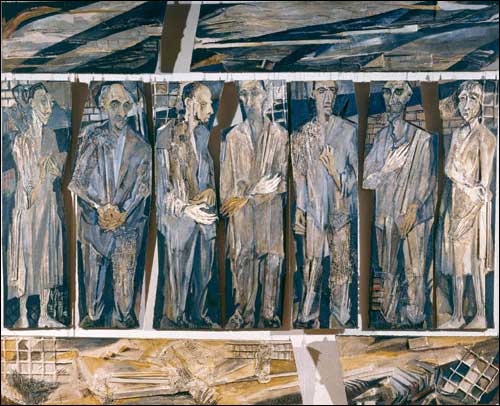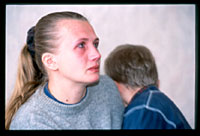The greatest industrial catastrophy in the history of humankind, the Chernobyl disaster, has never been the subject of an exhibition. Works of photographers or children’s drawings have been shown, but no attempt was made to show this huge event of contemporary history. This exhibition has taken years of patient on-site work, mainly in Ukraine, but also in Belarus and Russia. Its curator, Galia Ackerman, a French historian and journalist of Russian origin, went there to find photographs bearing witness to the catastrophe, archive footage from state television, medals, suits and honorary diplomas of “liquidators”, press cuttings, maps, children’s drawings and many other testimonies that have not yet been collected in museums.
The "Chernobyl accident"
What exactly happened at the power station? What action was taken to manage the “liquidation” of the consequences of what is called officially “the Chernobyl accident” How did the reality of Chernobyl become a fearsome test for the policy of glasnost launched by Mikhail Gorbachov? Why was it necessary to evacuate some 600 towns and villages, and permanently relocate 350,000 persons? What happened to the animals and plants? How do people live in “Chernobyl-land”, with its lasting contamination of a total surface area of 160,000 km? What are the health problems and the long-term consequences? How is a team of researchers devoted to “extreme ethnography” salvaging a “Ukrainian Atlantis”, the culture of the former region of Polesia, which spreads between Ukraine and Belarus? The challenge facing this exhibition is to answer these questions among many others.
In 24,110 years
While relating a story, the CCCB presents the visitor with true problems of the contemporary world. Time will never again be linear. It is now measured in seconds -a few seconds was all it took for the reactor to get out of control, and for a liquidator to “swallow” a border-line or even fatal dose of radioactivity. Time has since moved onto a geological scale that is measured in millennia, because some radioactive isotopes have a very long life, such as the plutonium-239 that contaminated the new town of Pripiat, where power station staff lived. Its period of activity (half-life) is 24,110 years, which means that, in 24 millennia, Pripiat will have half the present-day quality of this highly toxic element - the product of enriching uranium - that does not exist in nature.
A negative lottery
Our perception of space and distance has also been affected. It just took a few days for the famous “Chernobyl cloud” to make its way round the planet, touching almost a million human beings, many of whom live in countries where there are no nuclear power stations. We will never know for certain how many will suffer from cancer or other pathologies related to the passing of this cloud. Simply, as the great Ukrainian expert Dimitri Grodzinski put it, they unknowingly took part in a “negative lottery”. The geographical extension of directly contaminated areas is also shocking. The Sarcophagus is surrounded by cursed areas with vague, shifting borders, like quicksand: “Chernobyl-land” is a large country (a third of the size of Spain) inhabited by some nine million persons, including two million children...
Before and after
These questions of a philosophical nature are backed by the impact of works of art. Great Western photographers, such as Guillaume Herbaut and Robert Polidori, take a close look at the sordid universe of a post-industrial world, the world of Chernobyl. Prestigious artists such as the Ukrainian primitive painter Maria Primatchenko and the contemporary Russian painters Edward Stejnberg, Igor Makarevich and Maxime Kantor, and “a proponent of the sarcophagus”, the young French painter and philosopher Christophe Bisson, all make the spectator aware of the complex reality of Chernobyl before and after. Historical, educational and philosophical, this exhibition is a contribution to the future museum of the accident, a project conceived by the French thinker Paul Virilio.
It is an invitation to reflect on our human condition at a time when calamities pervade our daily lives.
Illustration: Christian Boisseaux-Chical Mother and child at the Sivitsa Hospital in Bielorussia. She has just been told the child has cancer
PUBLICATION
Exhibition catalogue Texts by Galia Ackerman, Christophe Bisson, Jean-Pierre Dupuy, Frédérick Lemarchand, Rostislav Omeliaixko and Ala Yar oixínskaia Interviews with Mikhail Gorbatxov, Dimitri Grodzinski, Yuri and Galina Bandajevski Spanish-English / Catalan-English, 17 x 24 cm, 200 pages , 175 ill. b/w and col. Institut d’Edicions de la Diputació de Barcelona and CCCB : 15 €
ISBN : 84-9803-120-6 (Catalan) / 84-9803-121-4 (Spanish)
To see more illustrations, click on VERSION FRANCAISE at the top of this page
| 








